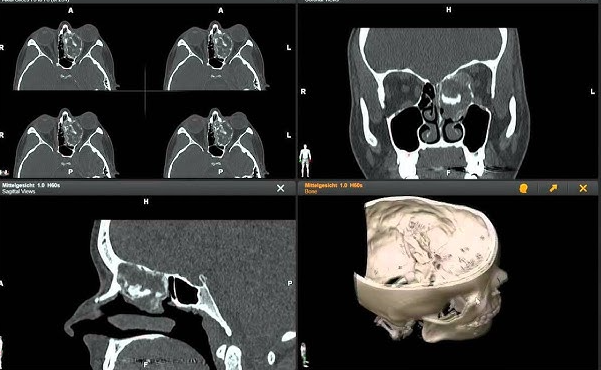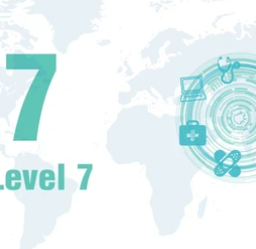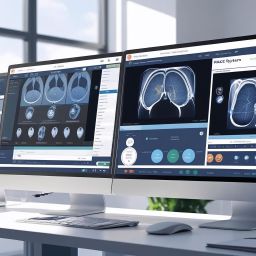
What is PACS and DICOM?
In the world of medical imaging, two terms often stand out: PACS and DICOM. If you’re in Saudi Arabia, UAE, Egypt, or anywhere across the MENA region, understanding these technologies is key to improving radiology services.
PACS (Picture Archiving and Communication System) and DICOM (Digital Imaging and Communications in Medicine) are used to store, share, and manage medical images like X-rays, MRIs, and CT scans. These systems help healthcare providers work faster, smarter, and more accurately.
HealthCluster, a leading digital health platform in the MENA region, provides advanced solutions for hospitals and clinics to integrate PACS and DICOM technology easily and securely.
What Does DICOM Stand For?
DICOM stands for Digital Imaging and Communications in Medicine. It is a standard used worldwide that allows medical imaging equipment like MRI and CT machines to create, store, and share images in a uniform format. Think of it as the “language” that different medical systems use to communicate with each other.
In countries like Qatar, Bahrain, and Jordan, DICOM ensures that imaging systems from different manufacturers can work together seamlessly, reducing costs and improving patient care.
What is the DICOM Protocol for PACS?
The DICOM protocol defines how data is exchanged between devices such as scanners, servers, and viewing software. When someone asks, “What is the DICOM protocol for PACS?” — it means how DICOM helps PACS to send, receive, and store medical images.
For example, when a radiologist in Oman captures an X-ray, DICOM formats the image so that it can be stored in the hospital’s PACS. This image can then be retrieved instantly by a doctor in Lebanon or Kuwait using the same standard.
What is PACS Used for in Radiology?
PACS is mainly used in radiology departments for the storage and retrieval of images. It removes the need for hard films and allows access to medical images from anywhere in the hospital — or even remotely. In busy healthcare environments such as in Egypt, Iran, or Turkey, PACS systems boost efficiency and reduce diagnostic delays.
Benefits of PACS in Radiology:
- Fast image access
- Reduced need for physical storage
- Remote consultation and second opinions
- Integration with EMR/EHR systems
- Enhanced diagnostic workflows
How Do I Send DICOM to PACS?
To send a DICOM file to PACS, the process typically follows these steps:
- The imaging device (CT, MRI, Ultrasound) captures the scan.
- The scan is saved in DICOM format.
- The DICOM file is sent to the PACS server using the DICOM protocol.
- PACS stores the image and makes it available for viewing.
This process is widely used in Sudan, Iraq, and Palestine to ensure timely access to patient imaging records.
How to Get a DICOM File from PACS?
You can retrieve a DICOM file from PACS using a DICOM viewer or PACS-integrated software. These tools allow medical professionals to open, analyze, and even export images for reports or referrals. Systems like those used in Libya and Morocco often allow easy sharing of files with other healthcare institutions or specialists.
What is DICOM in ECG?
DICOM is not just for X-rays or MRIs. It also supports ECG (Electrocardiogram) waveforms. In Tunisia and Mauritania, DICOM in ECG enables the digital storage and analysis of heart-related diagnostic images and data.
What is an Example of DICOM?
An example of DICOM would be a chest X-ray image taken in a hospital in Saudi Arabia, stored in .dcm format, and sent through PACS to a radiologist in another city. The radiologist uses a DICOM viewer to interpret the image and send back a report — all done electronically.
Are DICOM Files 3D?
Yes, DICOM files can be 3D. For example, CT and MRI scans often contain multiple image slices, which when stacked together, create a 3D image. This is especially helpful for surgical planning and diagnosis in advanced hospitals in UAE and Qatar.
What is the PACS Format?
PACS systems typically store images in DICOM format. However, the PACS format also includes metadata — like patient name, date, and the type of scan — which helps in organizing and retrieving the images efficiently.
What is Meant by PACS?
When someone asks, “What is meant by PACS?”, the simple answer is: it is a digital system used to store, retrieve, and manage medical images. PACS eliminates the need for physical films and allows for faster diagnosis and treatment.
What is the Primary Use of PACS?
The primary use of PACS is to manage and store diagnostic medical images. It allows doctors and radiologists to access images instantly and share them across departments or hospitals — especially crucial in emergency situations across regions like Syria, Yemen, and Jordan.
What is the Best PACS System for Radiology?
The best PACS system depends on your facility’s size and needs. For hospitals in the MENA region, HealthCluster recommends cloud-based PACS solutions with DICOM compatibility, AI-assisted diagnostics, and multilingual support.
HealthCluster provides one of the most reliable PACS and DICOM integration platforms in Saudi Arabia, UAE, and across MENA. Our systems are scalable, secure, and built for clinical excellence.
Why HealthCluster is Your Trusted Partner in PACS and DICOM
HealthCluster leads innovation in digital healthcare by providing intelligent imaging solutions that meet international standards. Whether you’re managing a single clinic in Bahrain or a network of hospitals in Turkey, our systems are designed to help you:
- Comply with global DICOM standards
- Integrate with radiology and EMR workflows
- Reduce turnaround time for diagnosis
- Improve patient satisfaction and clinical efficiency
Final Thoughts
So, what is PACS and DICOM? They are the backbone of modern medical imaging, transforming the way radiologists and doctors in the MENA region manage diagnostics. From faster access to 3D image analysis, and from remote consultations to AI-based detection, PACS and DICOM — especially when powered by HealthCluster — are shaping the future of healthcare.
If you’re looking to upgrade your hospital’s imaging system in Saudi Arabia, UAE, Egypt, or any MENA country, contact HealthCluster for a free consultation today.












